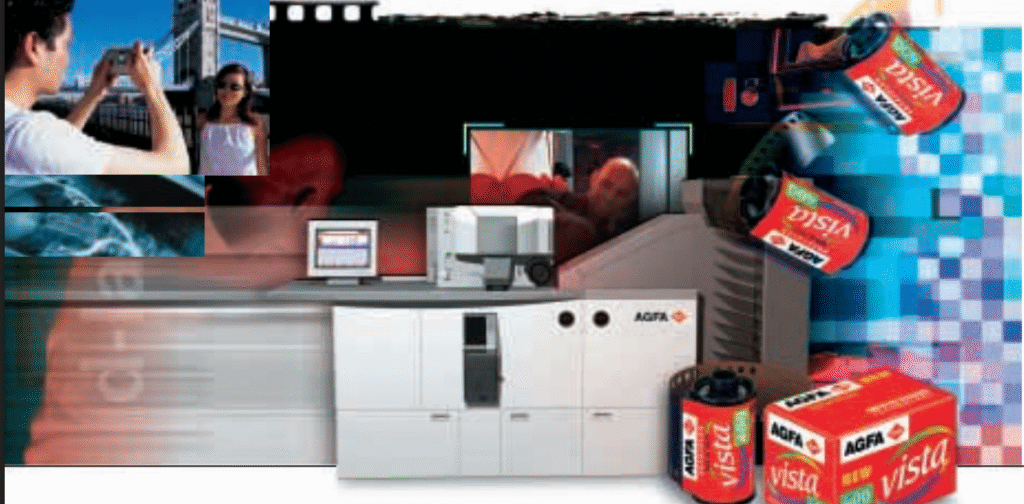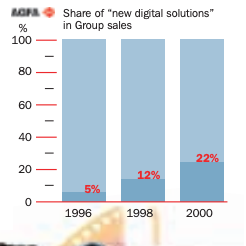When a new technology comes along that is capable of improving dramatically the products of a whole industry, every firm in that industry has vital strategic decisions to make. It must ask itself:
- How far and how quickly should we amend or abandon our
present products? - How far and how quickly should we embrace the new technology?
- Are we big enough and capable enough to accomplish all the
essential changes on our own? - How can we come out of this time of change stronger than we went in?
Once taken, these key decisions have to be implemented.

Technological change > Strategic decisions > Strategic implementation
All this makes for exciting times within the industry, for producers and also for consumers, who also have some adjusting to do.
Imaging is one of the world’s growth markets and new technology is making its mark; imaging has ‘gone digital’. It is not a complete transformation. Analogue imaging has not been abandoned and still has millions of satisfied consumers. However, the industry will move on. This is because the new technology:
- is genuinely innovative
- has undeniable advantages in some key aspects
- has been shown to work
- is proving reliable
- is capable of further development
- will become cheaper in the long run.
The pace of change is accelerating. Abandoning former practices and establishing new ways of working is generating not only excitement but also stress and tension. The new technology requires new skills, new attitudes and new approaches from both producers and consumers.
This case study looks at how AGFA, a leading player, is taking full advantage of the digital revolution. The company is using the new technology as:
- an engine for growing its business
- a means of providing its customers with better product possibilities and with greater flexibility and choice.

Agfa
Agfa is a leading name in the imaging industry. The Agfa-Gevaert Group develops, produces and distributes an extensive range of analogue and digital imaging systems. Agfa has divided its operations into three segments.
Segment: Consumer imaging.
Activity/Products: Wide range of products using both digital and analogue technologies for taking, processing and manipulating photographs.
Segment: Graphic systems.
Activity/Products: A wide range of electronic and photographic systems for the graphics industry, including workflow management systems, scanners and laser imagesetters.
Segment: Technical imaging.
Activity/Products: Medical uses eg X-ray equipment; non-destructive fault-testing eg in aircraft and pipelines; industrial imaging for motion pictures; document management systems and micrographics.
Agfa’s operations involve a high level of innovation. The company’s willingness and ability to work at the leading edge of technology help to make it a leader in its field.
Investment in new technologies

For Agfa to remain a market leader, its managers must concern themselves with the future and ask themselves:
- Where is the industry heading?
- What are our competitors likely to do next?
- Where do we go from here?
With imaging, the answers currently are:
- The industry is heading towards greater use of digital imaging.
- Our competitors will invest in research and development aimed at enhancing quality at affordable prices.
- We look to get there first, with better products to sell to customers who are prepared to use them.
This approach requires a willingness to invest heavily in new projects that maximise the benefits of new technology.
Investment appraisal
Every proposed project undergoes investment appraisal. This procedure establishes whether a particular project is worth taking forward. Managers will ask key questions about a proposal, including:
- How expensive are the initial outlay and the final total outlay likely to be?
- For how long are we likely to be spending money without any financial return?
- How long is it likely to be before we recover, from sales, all the money we have invested?
- What return can we reasonably expect from our investment in the long term?
- How big are the risks? What events over which we have little or no control could cause this project to falter or fail? How likely are they?
Risks for the imaging industry include:
- a significant rise in the cost of borrowing to finance investment
- a downturn in business activity worldwide that persuades industrial customers to postpone their own purchase of new plant and equipment
- poorer job prospects for the general public that deter private consumers from spending on the latest products.
Agfa must consider these factors as it contemplates large scale investment in new digitally based technologies.
During 2000 Agfa invested around 224 million Euros (equivalent to 4% of its sales revenue) in research and development. Part of this involved working with external partners eg universities and leading research centres. Much of the work reflected the need to move forward in:
- developing the transition from analogue to digital solutions
- meeting a wider variety of customer needs
- helping Agfa to create new market sectors and to enter them profitably.
The photographic marketplace

Digital technologies are changing the way in which people take, process and use images. New processes allow customers to work with images quickly and efficiently, without requiring extensive expertise and knowledge. Take, for example, the newspaper world. With newspapers, speed is vital and editors want the best pictures to go with the latest stories.
Digital technology is transforming newspaper production. For example, sports photographers no longer have to dash back to the office to develop prints, wondering anxiously what they have captured. They know immediately the quality of the image they have and they can despatch it immediately too. As a result, the publisher soon has on sale a comprehensive local Saturday night ‘sports special’ carrying action photos of spectacular moments that occurred hundreds of miles away just a short time earlier.
The new technology is also transforming photography for the general public. For example, crystal clear photos of a baby can now be available to proud, anxious grandparents thousands of miles away within a few minutes of an infant’s birth.
Analogue images
Technological advances do have a downside, in that demand for new products affects sales of older ones. As a market, analogue photography has almost reached maturity. It is still significant in size with almost 70% of the market. However, with plenty of scope for further product developments and for repeat business. The growth of digital technology has not deterred Agfa and its competitors from bringing out new, improved products for use with ‘old’ technology.

The real difference between analogue and digital lies in how images are recorded and processed. Analogue photography uses traditional cameras to expose the silver-halide film. This still remains the most widely used way to capture images. Customers are well served with a variety of excellent products, from traditional slide and print films to Advanced Photo Systems (APS) films and single-use cameras with enhanced capability.
Compared with digital systems, recent analogue advances are ‘low tech’, but so too is their cost. Image quality is excellent, and represents optimum value. The technology can also be applied widely; even single-use cameras take good pictures. However, analogue images cannot be viewed instantly, take time to enlarge or reduce and are on prints or negatives that cannot be re-used. Negatives need optimum storage conditions to remain in good condition long term. The chemicals used in processing also raise some environmental issues. Digital technology represents a genuine advance because it removes many of these difficulties.
Digital images
Digital images are based on a grid or matrix. They vary in the quality of their resolution, which is expressed in pixels or dots per inch (dpi) or millimetres. The higher the resolution, the better the picture, and the more expensive the equipment producing it.
There is a wide range of affordable digital cameras on the market now, offering varying levels of quality, capabilities and prices. There are also thousands of commercially available CD-ROMs offering images, graphics and more, all at different quality, sophistication and price levels. Consumers can also turn to the Internet, where millions of images are available for downloading to a PC.
Digital offers some real advantages. Images are held in a digital file and are available for use immediately. They can be transferred immediately from the camera to the PC, where they can be compressed, amended, altered and despatched using e-mail, fast ISDN lines and the internet. They can be downloaded and printed or transferred to CDs using recently developed copying equipment that retains image quality at a high level.
Consumers can take CDs to an Agfa Image Center where the quality, format and resolution can be chosen.
Digital images have transformed access, ease of use and transmission of images to provide a flexible series of solutions for customer needs. With instantaneous image capture, digital images require only minimal storage facilities.
Images can also be manipulated and altered and only the chosen images need to be put into print format.
However, at the present stage of development, really high quality digitally produced images do not come cheap; the equipment required is expensive. Professional users face high set-up costs, but in industries where speed, quality, and flexibility in use really matter, the price is worth paying.
Imaging is an industry where copyright is jealously guarded, and ease of transfer brings with it problems of security and copyright protection. Digital files can also be lost or become corrupted, so some form of backup is vital.
Agfa is aware of these additional consumer and business needs and continues to work on ways of meeting them.
Serving customer needs within each market
The imaging industry now has two main product markets: analogue and digital. Each product has strengths and weaknesses, the importance of which varies according to customer needs and requirements.
There remains a need for both analogue and digital imaging, depending on the requirements of client groups. For example, during construction, gas and oil pipelines need their joints X-rayed with periodical follow-up checks so that cracks and defects can be detected. This is a job for tried and tested analogue systems.
On the other hand, digital technologies have helped to transform the work of hospital radiologists. For example, a software package developed by Agfa called MUSICA (Multiscale Image Contrast Amplification) enables radiologists to manipulate X-ray images in various ways. Edges can be sharpened up to reveal key details, and images can be rotated to offer alternative perspectives. Users can zoom in on details, and select and sort images in a search for recurring patterns. Images can be shared across a number of hospital workstations and can also be transmitted for immediate expert analysis elsewhere.
Conclusion

The best investment programmes are supported by painstaking research: market research into what consumers require and product research to establish what the new technology can and cannot do for them. Agfa is at the heart of changes in imaging brought about by new technology. It is leading. It is also listening and learning. In a highly competitive industry, Agfa’s thorough approach is enabling it to retain important competitive advantages over its closest and fiercest rivals.
